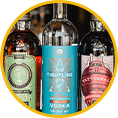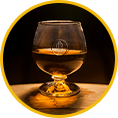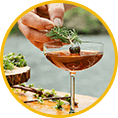Allow me, on this eve of a 70-degree Saturday, to amp up your summer 2019 drinking goals. Tattersall Distilling has done something very cool. They’ve distilled the Bootleg.
Of the dozens of craft distilleries popping up all over the Midwest, Tattersall Distilling in Minneapolis just might be the most prolific.
Tattersall’s is something different. Far closer to an amaro, it’s a dead ringer for an orange-inflected Campari, right down to the lovely reddish hue, with an intriguing array of aromatics and a pleasant bitter backbone. Give it a try in these three simple cocktails.
Tattersall’s project draws on the vast holdings of the WangensteenHistorical Library of Biology and Medicine at the University of Minnesota, one of the nation’s premier collections of medieval and early modern medical texts. Among its 72,000 volumes, some dating back to 1430, are hundreds of books detailing the curative properties of roots, weeds, seeds, metals and even animal parts like skins and horn.
Tattersall Crème De Fleur is something different. Rather than relying on a single blossom, it’s distilled with six aromatic flowers. As a result, it’s not an identifiable rose, or violet, or elderflower, for that matter. Instead, the scent is that of a sweet bouquet, more generally floral than it is one-note. With restrained sugar and a 30 percent ABV, we’ve found it awfully easy to use in cocktails.
According to co-founder Jon Kreidler, this amaro has a whopping 25 botanicals macerated in the organic corn spirit base. As is traditional with amari, it sits in oak for a spell so flavors will mingle to best effect. There’s a really cool savory quality to this amaro that presents itself with aromatics of dried porcini mushrooms, sage, fennel and cardamom. It’s bright and zippy on your palate and leaves a gentle, lingering bitter mintiness on your tongue that makes you want to pick it up again and again.
Gin has come a long way since it first appeared as genever in the mid-1500s. François De le Boë (sometimes known Franciscus Sylvius), a Dutch doctor looking to cure the tropical maladies suffered by Holland’s traders, is generally credited with spreading genever’s popularity. Eventually genever morphed into gin, which is based upon the spirits’ base ingredient, juniper berries. In 1700s London, gin truly came into its own since the clear spirit was safer to drink than the city’s polluted water, and was popularized as such, creating the first gin craze.
But even before Dutch genever gained ground as a cure, nearly a millennium ago Italian monks along the Almafi Coast were experimenting with distilling the same botanicals used to make gin today.
WITH A SURPRISING number of Fortune 500 companies (17) for such a small metropolitan area (Minneapolis and St. Paul together have only 725,000 residents), there’s a good chance you’ve been to the Twin Cities for a meeting. But you may have missed their greatest asset: drinking innovations that come from a long winter. When temperatures drop below freezing, locals at these bars get busy developing award- winning beverage programs to spark their homegrown spirits.
Minneapolis is America’s most intriguing food and drink city that no one’s talking about. Aside from Prince, Target, and the Twins, outsiders don’t know much about it, because traditionally there are only two kinds of people up there: those who never left, and natives who explored the world but returned. They’re fearless in the elements and worthy of validation—overdue for it, even—though in no way longing for it. As welcoming to outsiders as they are, “We’re just as happy to see you go,” one local admitted.
As the country descends upon Minneapolis for Super Bowl LII, stories of a Scandinavian-esque foodshed, revitalized industrial districts, and homegrown booze will be told, but it’s only a fraction of what makes it the best-kept secret in the north. Well, lucky for us, the word is finally out. Whether or not you’re headed there for the game, it’s time to put it in your sights.
 Spirits & Liqueurs
Spirits & Liqueurs Gift Cards
Gift Cards Merchandise
Merchandise Cask Club
Cask Club Featured Recipes
Featured Recipes Craft Cocktail Bar & Eatery
Craft Cocktail Bar & Eatery Retail Market
Retail Market Wedding Vendor Market
Wedding Vendor Market Event Calendar
Event Calendar Distillery Tours
Distillery Tours Classes
Classes Holiday Events
Holiday Events Maplefest
Maplefest Private Events
Private Events Weddings
Weddings Catering
Catering Sourcing &
Sourcing & Meet the Team
Meet the Team Media
Media Distributors
Distributors